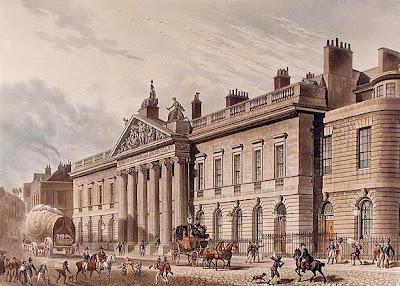East India Company (EIC), originally chartered as the Governor and Company of Merchants of London trading into the East Indies, and also called British East India Company, was an English company. Later (from 1707) it became a British joint-stock company, formed mainly for trading with the East Indies but that ended up doing business mainly with the Indian subcontinent, Qing Dynasty China, North-West Frontier Province and Baluchistan.
The British India company was established mainly to control
the spread of Dutch-Portuguese monopoly of the spice trade. The Dutch, Portuguese and Spanish maritime traders in those days had a dominant position in overseas mercantile operations and they were being well supported by their rulers, whereas the British were not as competitive as they were. British East India company was run by James Mill and his son with head office on Leaden Hall Street,
London.
The defeat of the Spanish Armada (1588) by England gave the English the needed break to cut the the monopoly of Spain and other countries . Until 1612 the company conducted voyages, separately subscribed. In the early stages in 1620s, the East India Company engaged in slave business, using slave labour and transporting enslaved people to its facilities in Southeast Asia and India as well as to the island of St. Helena in the Atlantic Ocean, west of Angola. Though th salves came from Indonesia and West Africa, the majority came from East Africa - from Mozambique or especially from Madagascar - and were primarily transported to the company’s holdings in India and Indonesia. Slave trade and large-scale transportation of slaves by the company peaked in the mid 1700s and lasted till 1770s .
There were temporary joint stocks until 1657, when a permanent joint stock was raised. After 1694 BEIC retained its dominant position despite competition from other British companies and continued to make large profits from India and by 1720, 15% of Britain's imports came from India. Subsequently the company rose to account for half of the world's trade, particularly trade in basic commodities that included cotton, silk, indigo dye, salt, salt peter, tea and opium. The company also ruled the beginnings of the British Empire in India.
 |
| Easy India co office, London. credit: wikipedia |
 |
| East India co tea. credit: clairepetras.com |
The defeat of the Spanish Armada (1588) by England gave the English the needed break to cut the the monopoly of Spain and other countries . Until 1612 the company conducted voyages, separately subscribed. In the early stages in 1620s, the East India Company engaged in slave business, using slave labour and transporting enslaved people to its facilities in Southeast Asia and India as well as to the island of St. Helena in the Atlantic Ocean, west of Angola. Though th salves came from Indonesia and West Africa, the majority came from East Africa - from Mozambique or especially from Madagascar - and were primarily transported to the company’s holdings in India and Indonesia. Slave trade and large-scale transportation of slaves by the company peaked in the mid 1700s and lasted till 1770s .
There were temporary joint stocks until 1657, when a permanent joint stock was raised. After 1694 BEIC retained its dominant position despite competition from other British companies and continued to make large profits from India and by 1720, 15% of Britain's imports came from India. Subsequently the company rose to account for half of the world's trade, particularly trade in basic commodities that included cotton, silk, indigo dye, salt, salt peter, tea and opium. The company also ruled the beginnings of the British Empire in India.
 |
| Add caption |
 |
| East India co. emblem. credit: academics.tjsst.edu |
 |
| pinterest.com |
 |
| greatgameindia.com |
 |
Madras Army, EIC. credit:www.rf792.org
|









